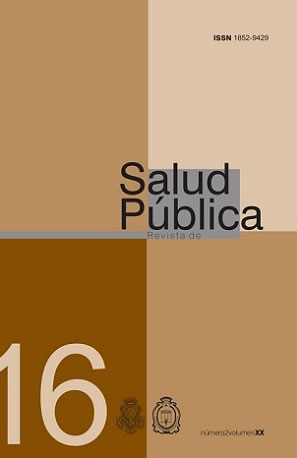KAÑIWA:NEW FOOD ALTERNATIVE FOR THE PREVENTION OF MALNUTRITION AND CARDIOVASCULAR DISEASES
DOI:
https://doi.org/10.31052/1853.1180.v20.n2.14351Keywords:
Kañiwa - functional food - malnutrition - obesityAbstract
Abstract
There are different Andean cereals, such as quinoa (Chenopodium quinoa) and amaranth (Amaranthus spp.) which are currently being appreciated because of their high nutritional value. Kañiwa (Chenopodium pallidicaule Aellen) represents a new food alternative due to its richness in nutrients.The objective of this research is to analyze the content of macro and micro nutrients present in the Kañiwa, so as to use it as functional food.The content of macro and micro nutrients was determined using AOAC-IRAM standards. Results: It is rich in proteins, iron, phosphorous, calcium, zinc, thiamine, niacin, riboflavin, ascorbic acid, oleic acid, linoleic acid, linolenic acid and it does not have trans fats.Conclusions: Kañiwa would contribute to improve hidden hunger, prevent the development of iron deficiency, optimize the functioning of the immune system and avoid the development of cardivascular diseases thanks to its content of healthy fats.
Downloads
References
Aellen P y T Just. Key and synopsis of the American species of the genus Cheno-podium L. American Midland Naturalist. 1943; 30: 47-67l.
Repo-Carrasco R., Espinoza C., Jacobsen S.E. Valor nutricional y usos de la quinua y la kañiwa. Jacobsen S.E., Portillo Z., eds. UNALM, Lima, Perú. Editor CIP. 2001: p. 391-400.
Repo-Carrasco, R., Espinoza, C. and Jacobsen, S.E. Nutritional Value and Use of the Andean Crops Quinoa (Chenopodium quinoa) and Kañiwa (Chenopodium pal-lidicaule). Food Rev. 2003; (19):179-189.
/10 Offi cial Methods of Analysis of the A.O.A.C. 13th Edition; Washington D.C., USA Association of Offi cial Analytical Chemists. 1980.
Machlin Editor. Handbook of vitamins. Second Ed. New York. 1991.
De Leenkeer A., Lambert W. and Nelis H. editors. Modern Chromatographic Analy-sis of Vitamins. Second Ed. 1992.
Nollet Leo ML editor. Food Analysis by HPLC. Second Ed. New York. 2000. 21Revista de Salud Pública, (XX) 2:17-21 Julio 2016Torrejón I. d. R.1, Martin B. L. 2, De La Puente T. B.3, Nasser J. R.4,Rizzi R.5 / La kañiwa: nueva alternativa alimentaria...
Instituto Argentino de Normalización y Certifi cación. Norma IRAM 5650 Parte II:Aceites y Grasas animales y vegetales. Método rápido de preparación de esteres metílicos de ácidos grasos, para su utilización en cromatografía gaseosa. 1982.
Fries A.M. Utilización de los Cultivos Andinos. Escuela Académica Profesional de Nutrición, Facultad de Medicina. Universidad Nacional de San Marcos. Lima. 1996.
Vallenas R.M., Carpio R.V.F. La Cañihua y su cultivo. Ministerio de la Agricultura, Zona Agraria XII, Boletín No. 25, Puno, Perú. 1974.
Institute of Medicine of the National Academies. Dietary reference intake. The essential guide for nutrient requirement. The National Academies Press. 2006.
Collazos, C., White, P., White, H., et al La Composición de Alimentos de Mayor Consumo en el Perú. Ministerio de Salud. Instituto Nacional de Nutrición. Lima, Perú. 1993.
White, P., Alvistur, E., Dias, C., et al. Nutrient content and Protein quality of quinoa and cañihua, edible seed products of the Andes Mountains. J. Agric. Food Chem.1955; 3(6):531-534.
Espinoza Silva, C. Caracterización de la fracción lipídica de quinoa (Chenopodium quinoa Willd) y kañiwa (Chenopodium pallidicaule Aellen). [Tesis para optar el grado de Magister Scientiae]. Lima, Perú. Universidad Nacional Agraria La Molina. 2002.
Massaro, M, de Caterina, R. Vasculoprotective effects of oleic acid: Epidemiological background and direct vascular antiatherogenic properties. Nutr Metab Cardiovasc Dis 2002; 12:42-51.
Mensink, RP, Katan, MB. Effect of dietary fatty acids on serum lipids and lipoproteins. A meta-analysis of 27 trials. Arterioscler Thromb 1992; 12:911-919.
Kris-Etherton, PM, Yu, S. Individual fatty acid effects on plasma lipids and lipoproteins: Human studies. Am J Clin Nutr 1997; 65 (Suppl.5):1628S-1644S.
Hu, FB, Manson, JE, Willett, WC. Types of dietary fat and risk of coronaryheart disease: A critical review. J Am Coll Nutr 2001; 20:5-19.
Mustad, VA, Ellsworth, JL, Cooper, AD, et al. Dietary linoleic acid increases and palmitic acid decreases hepatic LDL receptor protein and mRNA abundance in young pigs. J Lipid Res 1996; 37:2310-2323.
Yu-Poth, S, Yin, D, Zhao, G, et al. Conjugated linoleic acid upregu-lates LDL receptor gene expression in HepG2 cells. J Nutr 2004; 134:68-71.
Jump, DB. Dietary polyunsaturated fatty acids and regulation of gene transcription. Curr. Opin. Lipidol. 2002; 13:155-164.
Clarke, SD, Gasperikova, D, Nelson, C, Lapillonne, A, Heird, WC. Fatty acid regulation of gene expression: A genomic explanation for the benefi ts of the mediterranean diet. Ann NY Acad Sci. 2002; 967:283-298.
Simopoulos Artemis P. The Importance of the Omega-6/Omega-3 Fatty Acid Ratio in Cardiovascular Disease and Other Chronic Dis-eases Experimental Biology and Medicine.2008; 233:674-688.
Downloads
Published
How to Cite
Issue
Section
License
Authors who publish with this journal agree to the following terms:
- Authors retain copyright and grant the journal right of first publication with the work simultaneously licensed under a Creative Commons Attribution License which allows the work to be copied, distributed, exhibited and interpreted as long as it is not done for commercial purposes.
- Authors are able to enter into separate, additional contractual arrangements for the non-exclusive distribution of the journal's published version of the work (e.g., post it to an institutional repository or publish it in a book), with an acknowledgement of its initial publication in this journal.
- Authors are permitted and encouraged to post their work online (e.g., in institutional repositories or on their website) after the publication process. (See The Effect of Open Access). (See The Effect of Open Access).



